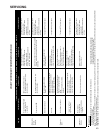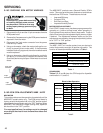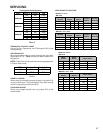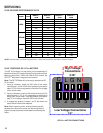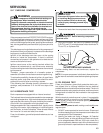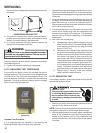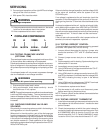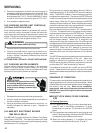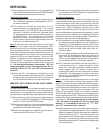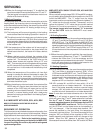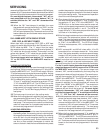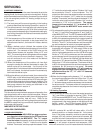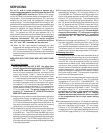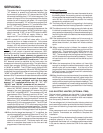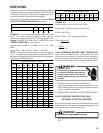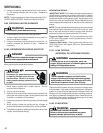
SERVICING
53
1.4 The compressor and condenser fan are turned off and
after a 65 second delay off, the relay on the EBTDR board
is de-energized and the blower is turned off.
2.0 Heating Operation
2.1 On a demand for heat, the room thermostat energizes
“W1” and 24Vac is supplied to heat sequencer, HR1, on
the heater assembly.
2.2 The contacts M1 and M2 will close within 10 to 20
seconds and turn on heater element #1. The normally
closed contacts on the EBTDR are also connected to
terminal M1. When M1 and M2 close, the blower motor
will be energized thru the normally closed contacts on
the EBTDR board. At the same time, if the heater
assembly contains a second heater element, HR1 will
contain a second set of contacts, M3 and M4, which will
close to turn on heater element #2.
Note: If more than two heater elements are on the heater
assembly, it will contain a second heat sequencer, HR2,
which will control the 3
rd
and 4
th
heater elements if available.
If the first stage heat demand, “W1” cannot be satisfied by the
heat pump, the temperature indoors will continue to drop. The
room thermostat will then energize “W2” and 24Vac will be
supplied to HR2 on the heater assembly. When the “W2”
demand is satisfied, the room thermostat will remove the
24Vac from HR2. The contacts on HR2 will open between 30
to 70 seconds and heater elements #3 and #4 will be turned
off. On most digital/electronic thermostats, “W2” will
remain energized until the first stage demand “W1” is
satisfied and then the “W1” and “W2” demands will be
removed.
2.3 When the “W1” heat demand is satisfied, the room
thermostat will remove the 24Vac from HR1. Both set of
contacts on the relay opens within 30 to 70 seconds and
turn off the heater element(s) and the blower motor.
MBR/AR*F WITH SINGLE STAGE HEAT PUMPS
3.0 Cooling Operation
On heat pump units, when the room thermostat set to the
cooling mode, 24Vac is supplied to “O” which energizes the
reversing valve. As long as the thermostat is set for cooling,
the reversing valve will be in the energized position for cooling.
3.1 On a demand for cooling, the room thermostat energizes
“G” and “Y” and 24Vac is supplied to “Y” at the heat pump
and the “G” terminal on the EBTDR board.
3.2 The heat pump turned on in the cooling mode and after
a 7 second on delay, the relay on the EBTDR board is
energized and the blower motor starts.
3.3 When the cooling demand is satisfied, the room thermo-
stat removes the 24Vac from “G” and “Y”.
3.4 The heat pump is turned off and after a 65 second delay
off, the relay on the EBTDR board is de-energized and
the blower motor is turned off.
4.0 Heating Operation
On heat pump units, when the room thermostat set to the
heating mode, the reversing valve is not energized. As long
as the thermostat is set for heating, the reversing valve will
be in the de-energized position for heating except during a
defrost cycle. Some installations may use one or more
outdoor thermostats to restrict the amount of electric heat
that is available above a preset ambient temperature. Use of
optional controls such as these can change the operation of
the electric heaters during the heating mode. This sequence
of operation does not cover those applications.
4.1 On a demand for first stage heat with heat pump units,
the room thermostat energizes “G” and “Y” and 24Vac is
supplied to “Y” at the heat pump unit and the “G” terminal
on the EBTDR board. The heat pump is turned on in the
heating mode and the blower motor starts after a 7
second on delay.
4.2 If the first stage heat demand cannot be satisfied by the
heat pump, the temperature indoors will continue to
drop. The room thermostat will then energize terminal
“W2’ for second stage heat and 24Vac will be supplied
to heat sequencer HR1 on the heater assembly.
4.3 HR1 contacts M1 and M2 will close will close within 10
to 20 seconds and turn on heater element #1. At the
same time, if the heater assembly contains a second
heater element, HR1 will contain a second set of
contacts, M3 and M4, which will close and turn on heater
element #2. The blower motor is already on as a result
of terminal “G” on the EBTDR board being energized for
the first stage heat demand.
Note: If more than two heater elements are on the heater
assembly, it will contain a second heat sequencer, HR2,
which will control the 3
rd
and 4
th
heater elements if available.
If the second stage heat demand, “W2” cannot be satisfied
by the heat pump, the temperature indoors will continue to
drop. The room thermostat will then energize “W3” and
24Vac will be supplied to HR2 on the heater assembly.
When the “W3” demand is satisfied, the room thermostat will
remove the 24Vac from HR2. The contacts on HR2 will open
between 30 to 70 seconds and heater elements #3 and #4 will
be turned off. On most digital/electronic thermostats,
“W3” will remain energized until the first stage heat
demand “Y” is satisfied and then the “G”, “Y”, “W2”
and “W3” demands will be removed.
4.4 As the temperature indoors increase, it will reach a point
where the second stage heat demand, “W2”, is satisfied.
When this happens, the room thermostat will remove the
24Vac from the coil of HR1. The contacts on HR1 will
open between 30 to 70 seconds and turn off both heater
element(s). The heat pump remains on along with the
blower motor because the “Y” demand for first stage heat
will still be present.



